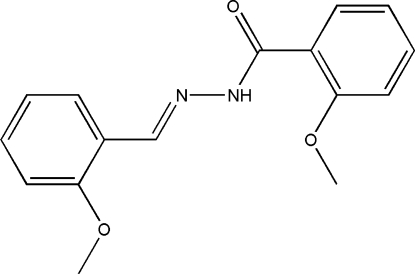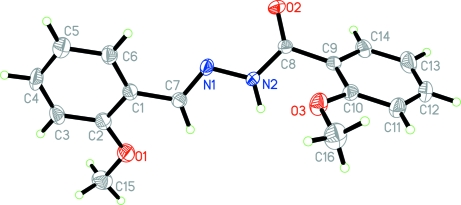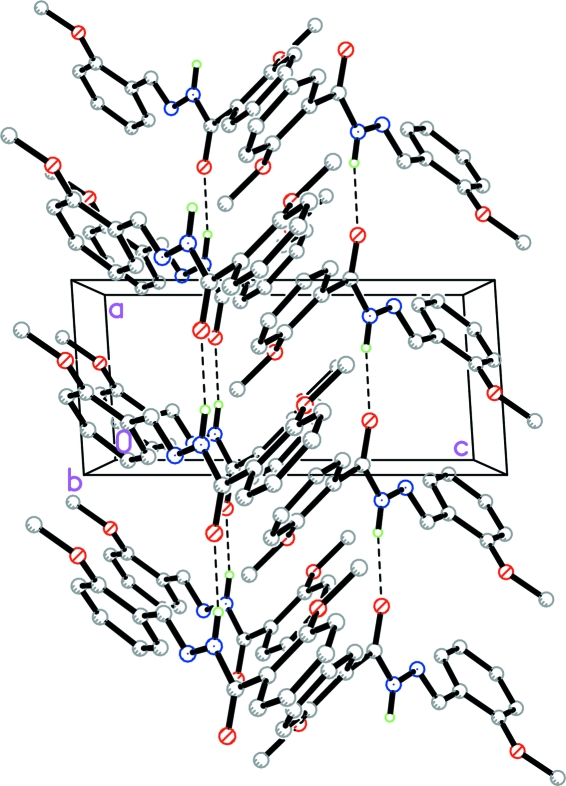Abstract
The title Schiff base compound, C16H16N2O3, was derived from the condensation of 2-methoxybenzaldehyde with 2-methoxybenzohydrazide in an ethanol solution. The dihedral angle between the two aromatic rings is 87.5 (3)°. In the crystal structure, the molecules are linked into chains running parallel to the a axis by intermolecular N—H⋯O hydrogen bonds.
Related literature
For related literature, see: Lu et al. (2008a
▶,b
▶); Nie (2008 ▶); He (2008 ▶); Shi et al. (2007 ▶). For bond-length data, see: Allen et al. (1987 ▶).
Experimental
Crystal data
C16H16N2O3
M r = 284.31
Monoclinic,

a = 4.9998 (13) Å
b = 13.475 (4) Å
c = 10.824 (3) Å
β = 93.674 (4)°
V = 727.7 (4) Å3
Z = 2
Mo Kα radiation
μ = 0.09 mm−1
T = 298 (2) K
0.30 × 0.30 × 0.28 mm
Data collection
Bruker APEXII CCD area-detector diffractometer
Absorption correction: multi-scan (SADABS; Sheldrick, 2004 ▶) T min = 0.973, T max = 0.975
6081 measured reflections
1647 independent reflections
1229 reflections with I > 2σ(I)
R int = 0.055
Refinement
R[F 2 > 2σ(F 2)] = 0.050
wR(F 2) = 0.095
S = 1.11
1647 reflections
195 parameters
2 restraints
H atoms treated by a mixture of independent and constrained refinement
Δρmax = 0.15 e Å−3
Δρmin = −0.14 e Å−3
Data collection: APEX2 (Bruker, 2004 ▶); cell refinement: SAINT (Bruker, 2004 ▶); data reduction: SAINT; program(s) used to solve structure: SHELXS97 (Sheldrick, 2008 ▶); program(s) used to refine structure: SHELXL97 (Sheldrick, 2008 ▶); molecular graphics: SHELXTL (Sheldrick, 2008 ▶); software used to prepare material for publication: SHELXTL.
Supplementary Material
Crystal structure: contains datablocks global, I. DOI: 10.1107/S160053680802521X/ci2648sup1.cif
Structure factors: contains datablocks I. DOI: 10.1107/S160053680802521X/ci2648Isup2.hkl
Additional supplementary materials: crystallographic information; 3D view; checkCIF report
Table 1. Hydrogen-bond geometry (Å, °).
| D—H⋯A | D—H | H⋯A | D⋯A | D—H⋯A |
|---|---|---|---|---|
| N2—H2⋯O2i | 0.90 (1) | 1.99 (1) | 2.873 (3) | 167 (4) |
Symmetry code: (i)  .
.
Acknowledgments
The authors acknowledge Shaanxi University of Technology for the research fund.
supplementary crystallographic information
Comment
As part of our investigation of the crystal structures of Schiff bases derived from the condensation of aldehydes with benzohydrazides (Lu et al., 2008a,b), we report here the crystal structure of the title new Schiff base compound.
In the title molecule (Fig. 1). the bond lengths have normal values (Allen et al., 1987), and are comparable to those observed in related compounds (Nie, 2008; He, 2008; Shi et al., 2007). The dihedral angle between the two aromatic rings is 87.5 (3)°, indicating that they are almost perpendicular to one another.
In the crystal structure, the molecules are linked into chains (Fig. 2) running parallel to the a axis by intermolecular N–H···O hydrogen bonds (Table 1).
Experimental
The title compound was prepared by the Schiff base condensation of 2-methoxybenzaldehyde (0.1 mol) and 2-methoxybenzohydrazide (0.1 mmol) in ethanol (50 ml). The excess ethanol was removed by distillation. The colorless solid obtained was filtered and washed with ethanol. Single crystals suitable for X-ray diffraction were obatined by slow evaporation of an ethanol solution at room temperature.
Refinement
The imino H atom was located in a difference map and refined with a N–H distance restraint of 0.90 (1) Å. The other H atoms were positioned geometrically (C–H = 0.93-0.96 Å) and refined using a riding model, with Uiso(H) = 1.2Ueq(C) and 1.5Ueq(Cmethyl). In the absence of significant anomalous scattering, Friedel pairs were merged.
Figures
Fig. 1.
The molecular structure of the title compound, showing 30% probability displacement ellipsoids and the atom-numbering scheme. Dashed lines indicate hydrogen bonds.
Fig. 2.
The crystal packing of the title compound, viewed along the b axis. Dashed lines indicate hydrogen bonds.
Crystal data
| C16H16N2O3 | F000 = 300 |
| Mr = 284.31 | Dx = 1.297 Mg m−3 |
| Monoclinic, P21 | Mo Kα radiation λ = 0.71073 Å |
| Hall symbol: P 2yb | Cell parameters from 744 reflections |
| a = 4.9998 (13) Å | θ = 2.5–24.0º |
| b = 13.475 (4) Å | µ = 0.09 mm−1 |
| c = 10.824 (3) Å | T = 298 (2) K |
| β = 93.674 (4)º | Block, colourless |
| V = 727.7 (4) Å3 | 0.30 × 0.30 × 0.28 mm |
| Z = 2 |
Data collection
| Bruker APEXII CCD area-detector diffractometer | 1647 independent reflections |
| Radiation source: fine-focus sealed tube | 1229 reflections with I > 2σ(I) |
| Monochromator: graphite | Rint = 0.055 |
| T = 298(2) K | θmax = 27.0º |
| ω scans | θmin = 1.9º |
| Absorption correction: multi-scan(SADABS; Sheldrick, 2004) | h = −6→6 |
| Tmin = 0.973, Tmax = 0.975 | k = −17→16 |
| 6081 measured reflections | l = −13→13 |
Refinement
| Refinement on F2 | Secondary atom site location: difference Fourier map |
| Least-squares matrix: full | Hydrogen site location: inferred from neighbouring sites |
| R[F2 > 2σ(F2)] = 0.050 | H atoms treated by a mixture of independent and constrained refinement |
| wR(F2) = 0.095 | w = 1/[σ2(Fo2) + (0.0297P)2] where P = (Fo2 + 2Fc2)/3 |
| S = 1.11 | (Δ/σ)max = 0.001 |
| 1647 reflections | Δρmax = 0.16 e Å−3 |
| 195 parameters | Δρmin = −0.14 e Å−3 |
| 2 restraints | Extinction correction: none |
| Primary atom site location: structure-invariant direct methods |
Special details
| Geometry. All esds (except the esd in the dihedral angle between two l.s. planes) are estimated using the full covariance matrix. The cell esds are taken into account individually in the estimation of esds in distances, angles and torsion angles; correlations between esds in cell parameters are only used when they are defined by crystal symmetry. An approximate (isotropic) treatment of cell esds is used for estimating esds involving l.s. planes. |
| Refinement. Refinement of F2 against ALL reflections. The weighted R-factor wR and goodness of fit S are based on F2, conventional R-factors R are based on F, with F set to zero for negative F2. The threshold expression of F2 > 2sigma(F2) is used only for calculating R-factors(gt) etc. and is not relevant to the choice of reflections for refinement. R-factors based on F2 are statistically about twice as large as those based on F, and R- factors based on ALL data will be even larger. |
Fractional atomic coordinates and isotropic or equivalent isotropic displacement parameters (Å2)
| x | y | z | Uiso*/Ueq | ||
| O1 | 0.4130 (5) | 0.5063 (2) | 1.0258 (2) | 0.0579 (8) | |
| O2 | 1.2673 (4) | 0.71624 (19) | 0.6930 (2) | 0.0436 (6) | |
| O3 | 0.6361 (5) | 0.7245 (2) | 0.4683 (2) | 0.0513 (6) | |
| N1 | 0.8931 (5) | 0.5916 (2) | 0.7771 (2) | 0.0357 (7) | |
| N2 | 0.8339 (5) | 0.67811 (19) | 0.7116 (3) | 0.0354 (7) | |
| C1 | 0.7337 (7) | 0.4561 (2) | 0.8904 (3) | 0.0371 (9) | |
| C2 | 0.5766 (7) | 0.4321 (3) | 0.9892 (3) | 0.0426 (9) | |
| C3 | 0.6008 (7) | 0.3398 (3) | 1.0439 (3) | 0.0501 (10) | |
| H3 | 0.4953 | 0.3233 | 1.1086 | 0.060* | |
| C4 | 0.7794 (8) | 0.2725 (3) | 1.0032 (4) | 0.0549 (11) | |
| H4 | 0.7928 | 0.2102 | 1.0400 | 0.066* | |
| C5 | 0.9407 (8) | 0.2954 (3) | 0.9081 (4) | 0.0537 (10) | |
| H5 | 1.0645 | 0.2498 | 0.8818 | 0.064* | |
| C6 | 0.9142 (7) | 0.3876 (3) | 0.8529 (3) | 0.0455 (9) | |
| H6 | 1.0216 | 0.4036 | 0.7887 | 0.055* | |
| C7 | 0.6996 (7) | 0.5520 (2) | 0.8295 (3) | 0.0377 (8) | |
| H7 | 0.5353 | 0.5844 | 0.8291 | 0.045* | |
| C8 | 1.0305 (6) | 0.7328 (2) | 0.6674 (3) | 0.0296 (7) | |
| C9 | 0.9390 (6) | 0.8198 (2) | 0.5913 (3) | 0.0343 (8) | |
| C10 | 0.7391 (6) | 0.8162 (3) | 0.4959 (3) | 0.0358 (8) | |
| C11 | 0.6635 (7) | 0.9012 (3) | 0.4321 (3) | 0.0518 (10) | |
| H11 | 0.5257 | 0.8990 | 0.3703 | 0.062* | |
| C12 | 0.7913 (8) | 0.9890 (3) | 0.4597 (4) | 0.0606 (12) | |
| H12 | 0.7384 | 1.0462 | 0.4168 | 0.073* | |
| C13 | 0.9946 (8) | 0.9936 (3) | 0.5493 (4) | 0.0617 (12) | |
| H13 | 1.0835 | 1.0533 | 0.5659 | 0.074* | |
| C14 | 1.0677 (7) | 0.9096 (3) | 0.6151 (4) | 0.0478 (10) | |
| H14 | 1.2059 | 0.9131 | 0.6767 | 0.057* | |
| C15 | 0.2563 (8) | 0.4878 (4) | 1.1267 (4) | 0.0653 (12) | |
| H15A | 0.1495 | 0.4295 | 1.1105 | 0.098* | |
| H15B | 0.1410 | 0.5435 | 1.1385 | 0.098* | |
| H15C | 0.3714 | 0.4778 | 1.2001 | 0.098* | |
| C16 | 0.4372 (8) | 0.7167 (4) | 0.3692 (3) | 0.0712 (12) | |
| H16A | 0.2821 | 0.7542 | 0.3885 | 0.107* | |
| H16B | 0.3884 | 0.6483 | 0.3573 | 0.107* | |
| H16C | 0.5066 | 0.7422 | 0.2949 | 0.107* | |
| H2 | 0.662 (3) | 0.696 (3) | 0.696 (3) | 0.080* |
Atomic displacement parameters (Å2)
| U11 | U22 | U33 | U12 | U13 | U23 | |
| O1 | 0.0577 (16) | 0.0581 (19) | 0.0601 (19) | 0.0064 (15) | 0.0196 (15) | 0.0132 (15) |
| O2 | 0.0265 (12) | 0.0451 (14) | 0.0586 (14) | 0.0050 (12) | −0.0024 (10) | 0.0062 (13) |
| O3 | 0.0604 (15) | 0.0471 (15) | 0.0439 (13) | −0.0052 (14) | −0.0149 (11) | 0.0053 (14) |
| N1 | 0.0391 (16) | 0.0318 (15) | 0.0356 (15) | 0.0028 (13) | −0.0030 (13) | 0.0079 (13) |
| N2 | 0.0271 (14) | 0.0357 (16) | 0.0428 (16) | 0.0036 (13) | −0.0018 (13) | 0.0124 (13) |
| C1 | 0.037 (2) | 0.038 (2) | 0.0354 (19) | −0.0036 (16) | −0.0070 (16) | 0.0053 (16) |
| C2 | 0.041 (2) | 0.046 (2) | 0.040 (2) | −0.0060 (18) | −0.0050 (18) | 0.0062 (18) |
| C3 | 0.054 (2) | 0.051 (3) | 0.045 (2) | −0.011 (2) | −0.0020 (18) | 0.0176 (19) |
| C4 | 0.069 (3) | 0.035 (2) | 0.058 (3) | 0.000 (2) | −0.016 (2) | 0.018 (2) |
| C5 | 0.061 (3) | 0.043 (2) | 0.056 (3) | 0.0023 (19) | −0.001 (2) | 0.001 (2) |
| C6 | 0.049 (2) | 0.042 (2) | 0.045 (2) | −0.0021 (19) | 0.0002 (18) | 0.0085 (18) |
| C7 | 0.0336 (18) | 0.043 (2) | 0.0357 (19) | 0.0002 (16) | −0.0008 (16) | 0.0078 (16) |
| C8 | 0.0279 (17) | 0.0279 (18) | 0.0332 (16) | −0.0013 (15) | 0.0026 (13) | −0.0029 (15) |
| C9 | 0.0317 (17) | 0.0346 (19) | 0.0377 (18) | 0.0046 (15) | 0.0098 (14) | 0.0017 (16) |
| C10 | 0.0368 (19) | 0.0353 (19) | 0.0357 (19) | 0.0037 (16) | 0.0051 (15) | 0.0015 (17) |
| C11 | 0.055 (2) | 0.056 (3) | 0.044 (2) | 0.008 (2) | 0.001 (2) | 0.013 (2) |
| C12 | 0.065 (3) | 0.046 (3) | 0.071 (3) | 0.007 (2) | 0.009 (2) | 0.027 (2) |
| C13 | 0.072 (3) | 0.039 (2) | 0.076 (3) | −0.010 (2) | 0.014 (3) | 0.008 (2) |
| C14 | 0.048 (2) | 0.037 (2) | 0.058 (2) | −0.0087 (19) | 0.0060 (19) | 0.003 (2) |
| C15 | 0.060 (3) | 0.083 (3) | 0.054 (3) | −0.002 (3) | 0.012 (2) | 0.009 (2) |
| C16 | 0.077 (3) | 0.078 (3) | 0.055 (2) | −0.014 (3) | −0.023 (2) | 0.009 (3) |
Geometric parameters (Å, °)
| O1—C2 | 1.367 (4) | C6—H6 | 0.93 |
| O1—C15 | 1.407 (4) | C7—H7 | 0.93 |
| O2—C8 | 1.220 (3) | C8—C9 | 1.488 (4) |
| O3—C10 | 1.364 (4) | C9—C14 | 1.387 (5) |
| O3—C16 | 1.419 (4) | C9—C10 | 1.391 (4) |
| N1—C7 | 1.270 (4) | C10—C11 | 1.378 (5) |
| N1—N2 | 1.387 (3) | C11—C12 | 1.368 (5) |
| N2—C8 | 1.341 (4) | C11—H11 | 0.93 |
| N2—H2 | 0.901 (10) | C12—C13 | 1.360 (5) |
| C1—C6 | 1.370 (5) | C12—H12 | 0.93 |
| C1—C2 | 1.405 (5) | C13—C14 | 1.375 (5) |
| C1—C7 | 1.456 (4) | C13—H13 | 0.93 |
| C2—C3 | 1.380 (5) | C14—H14 | 0.93 |
| C3—C4 | 1.365 (5) | C15—H15A | 0.96 |
| C3—H3 | 0.93 | C15—H15B | 0.96 |
| C4—C5 | 1.383 (5) | C15—H15C | 0.96 |
| C4—H4 | 0.93 | C16—H16A | 0.96 |
| C5—C6 | 1.381 (5) | C16—H16B | 0.96 |
| C5—H5 | 0.93 | C16—H16C | 0.96 |
| C2—O1—C15 | 118.0 (3) | C14—C9—C10 | 118.1 (3) |
| C10—O3—C16 | 118.0 (3) | C14—C9—C8 | 117.5 (3) |
| C7—N1—N2 | 115.9 (3) | C10—C9—C8 | 124.3 (3) |
| C8—N2—N1 | 120.5 (2) | O3—C10—C11 | 123.8 (3) |
| C8—N2—H2 | 120 (3) | O3—C10—C9 | 115.9 (3) |
| N1—N2—H2 | 120 (3) | C11—C10—C9 | 120.3 (3) |
| C6—C1—C2 | 118.8 (3) | C12—C11—C10 | 120.0 (4) |
| C6—C1—C7 | 121.6 (3) | C12—C11—H11 | 120.0 |
| C2—C1—C7 | 119.6 (3) | C10—C11—H11 | 120.0 |
| O1—C2—C3 | 125.0 (3) | C13—C12—C11 | 120.8 (4) |
| O1—C2—C1 | 115.3 (3) | C13—C12—H12 | 119.6 |
| C3—C2—C1 | 119.7 (4) | C11—C12—H12 | 119.6 |
| C4—C3—C2 | 120.1 (4) | C12—C13—C14 | 119.6 (4) |
| C4—C3—H3 | 120.0 | C12—C13—H13 | 120.2 |
| C2—C3—H3 | 119.9 | C14—C13—H13 | 120.2 |
| C3—C4—C5 | 121.1 (3) | C13—C14—C9 | 121.2 (4) |
| C3—C4—H4 | 119.5 | C13—C14—H14 | 119.4 |
| C5—C4—H4 | 119.5 | C9—C14—H14 | 119.4 |
| C6—C5—C4 | 118.6 (4) | O1—C15—H15A | 109.5 |
| C6—C5—H5 | 120.7 | O1—C15—H15B | 109.5 |
| C4—C5—H5 | 120.7 | H15A—C15—H15B | 109.5 |
| C1—C6—C5 | 121.6 (4) | O1—C15—H15C | 109.5 |
| C1—C6—H6 | 119.2 | H15A—C15—H15C | 109.5 |
| C5—C6—H6 | 119.2 | H15B—C15—H15C | 109.5 |
| N1—C7—C1 | 120.3 (3) | O3—C16—H16A | 109.5 |
| N1—C7—H7 | 119.9 | O3—C16—H16B | 109.5 |
| C1—C7—H7 | 119.9 | H16A—C16—H16B | 109.5 |
| O2—C8—N2 | 122.8 (3) | O3—C16—H16C | 109.5 |
| O2—C8—C9 | 122.0 (3) | H16A—C16—H16C | 109.5 |
| N2—C8—C9 | 115.1 (3) | H16B—C16—H16C | 109.5 |
Hydrogen-bond geometry (Å, °)
| D—H···A | D—H | H···A | D···A | D—H···A |
| N2—H2···O2i | 0.90 (1) | 1.99 (1) | 2.873 (3) | 167 (4) |
Symmetry codes: (i) x−1, y, z.
Footnotes
Supplementary data and figures for this paper are available from the IUCr electronic archives (Reference: CI2648).
References
- Allen, F. H., Kennard, O., Watson, D. G., Brammer, L., Orpen, A. G. & Taylor, R. (1987). J. Chem. Soc. Perkin Trans. 2, pp. S1–S19.
- Bruker (2004). APEX2 and SAINT Bruker AXS Inc., Madison, Wisconsin, USA.
- He, L. (2008). Acta Cryst. E64, o82.
- Lu, J.-F., Min, S.-T., Ji, X.-H. & Dang, Z.-H. (2008a). Acta Cryst. E64, o1693. [DOI] [PMC free article] [PubMed]
- Lu, J.-F., Min, S.-T., Ji, X.-H. & Dang, Z.-H. (2008b). Acta Cryst. E64, o1694. [DOI] [PMC free article] [PubMed]
- Nie, Y. (2008). Acta Cryst. E64, o471. [DOI] [PMC free article] [PubMed]
- Sheldrick, G. M. (2004). SADABS University of Göttingen, Germany.
- Sheldrick, G. M. (2008). Acta Cryst. A64, 112–122. [DOI] [PubMed]
- Shi, X.-F., Liu, C.-Y., Liu, B. & Yuan, C.-C. (2007). Acta Cryst. E63, o1295–o1296.
Associated Data
This section collects any data citations, data availability statements, or supplementary materials included in this article.
Supplementary Materials
Crystal structure: contains datablocks global, I. DOI: 10.1107/S160053680802521X/ci2648sup1.cif
Structure factors: contains datablocks I. DOI: 10.1107/S160053680802521X/ci2648Isup2.hkl
Additional supplementary materials: crystallographic information; 3D view; checkCIF report




